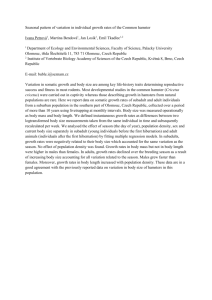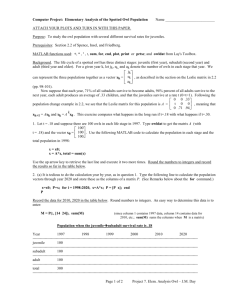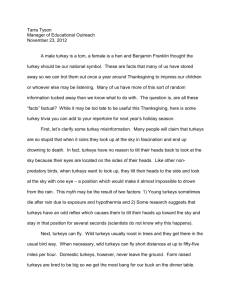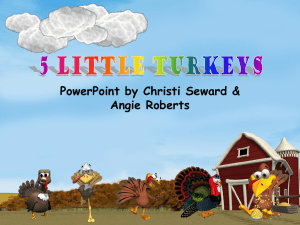AGE AND GENDER CLASSIFICATION OF MERRIAM’S TURKEYS FROM FOOT MEASUREMENTS
advertisement
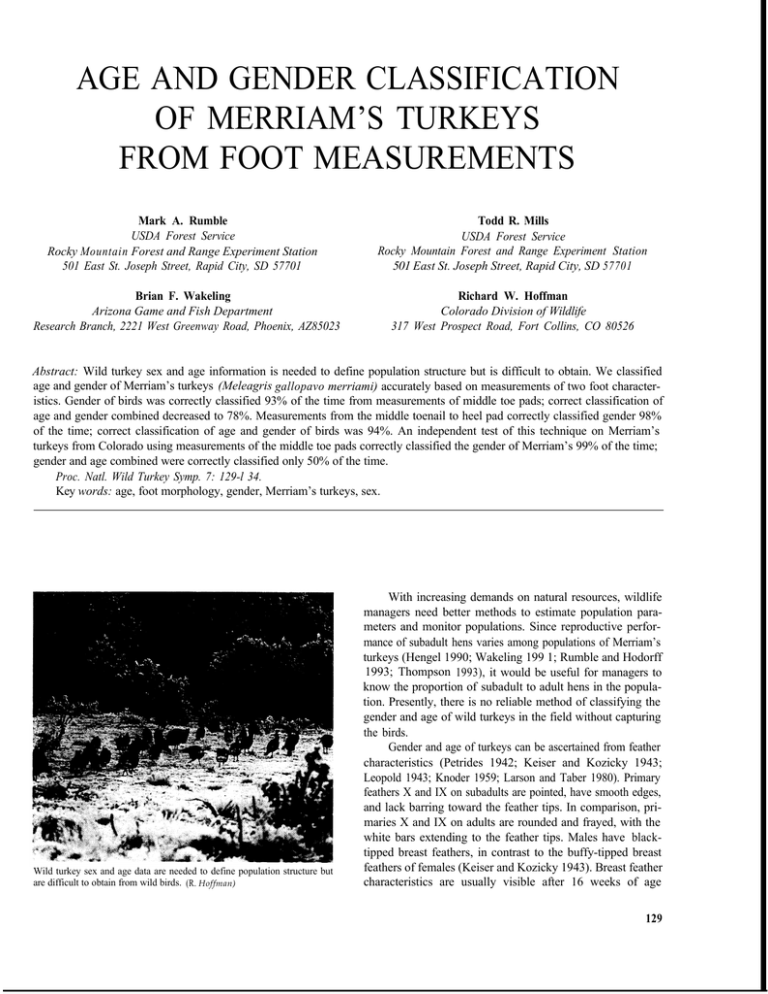
AGE AND GENDER CLASSIFICATION OF MERRIAM’S TURKEYS FROM FOOT MEASUREMENTS Mark A. Rumble USDA Forest Service Rocky Mountain Forest and Range Experiment Station 501 East St. Joseph Street, Rapid City, SD 57701 Brian F. Wakeling Arizona Game and Fish Department Research Branch, 2221 West Greenway Road, Phoenix, AZ85023 Todd R. Mills USDA Forest Service Rocky Mountain Forest and Range Experiment Station 501 East St. Joseph Street, Rapid City, SD 57701 Richard W. Hoffman Colorado Division of Wildlife 317 West Prospect Road, Fort Collins, CO 80526 Abstract: Wild turkey sex and age information is needed to define population structure but is difficult to obtain. We classified age and gender of Merriam’s turkeys (Meleagris gallopavo merriami) accurately based on measurements of two foot characteristics. Gender of birds was correctly classified 93% of the time from measurements of middle toe pads; correct classification of age and gender combined decreased to 78%. Measurements from the middle toenail to heel pad correctly classified gender 98% of the time; correct classification of age and gender of birds was 94%. An independent test of this technique on Merriam’s turkeys from Colorado using measurements of the middle toe pads correctly classified the gender of Merriam’s 99% of the time; gender and age combined were correctly classified only 50% of the time. Proc. Natl. Wild Turkey Symp. 7: 129-l 34. Key words: age, foot morphology, gender, Merriam’s turkeys, sex. Wild turkey sex and age data are needed to define population structure but are difficult to obtain from wild birds. (R. Hoffman) With increasing demands on natural resources, wildlife managers need better methods to estimate population parameters and monitor populations. Since reproductive performance of subadult hens varies among populations of Merriam’s turkeys (Hengel 1990; Wakeling 199 1; Rumble and Hodorff 1993; Thompson 1993), it would be useful for managers to know the proportion of subadult to adult hens in the population. Presently, there is no reliable method of classifying the gender and age of wild turkeys in the field without capturing the birds. Gender and age of turkeys can be ascertained from feather characteristics (Petrides 1942; Keiser and Kozicky 1943; Leopold 1943; Knoder 1959; Larson and Taber 1980). Primary feathers X and IX on subadults are pointed, have smooth edges, and lack barring toward the feather tips. In comparison, primaries X and IX on adults are rounded and frayed, with the white bars extending to the feather tips. Males have blacktipped breast feathers, in contrast to the buffy-tipped breast feathers of females (Keiser and Kozicky 1943). Breast feather characteristics are usually visible after 16 weeks of age 129 132 +- Techniques a Table 3. Incremental lengths of middle toenail to heel pad and probabilities for classifying gender and gender-age categories using this measurement for Merriam’s turkeys. Probability Toenail to b heel pad Subadult Probability (cm) Female Male Predicted gender 8.3 8.4 8.5 8.6 8.7 8.8 8.9 9.0 9.1 9.2 9.3 9.4 9.5 9.6 9.7 9.8 9.9 10.0 10.1 10.2 10.3 10.4 10.5 10.6 10.7 10.8 10.9 11.0 11.1 11.2 11.3 11.4 11.5 11.6 11.7 11.8 11.9 12.0 12.1 12.2 12.3 1.00 1 .00 1 .00 1.00 1 .00 1.00 1.00 1 .00 1.00 1.00 1 .00 1.00 1.00 1 .00 1.00 1.00 0.99 0.97 0.94 0.85 0.69 0.46 0.25 0.12 0.05 0.02 0.01 0.00 0.00 0.00 0.00 0.00 0.00 0.00 0.00 0.00 0.00 0.00 0.00 0.00 0.00 0.00 0.00 0.00 0.00 0.00 0.00 0.00 0.00 0.00 0.00 0.00 0.00 0.00 0.00 0.00 0.00 0.01 0.03 0.07 0.15 0.3 1 0.54 0.75 0.89 0.95 0.98 0.99 1.00 1.00 1 .00 1 .00 1.00 1.00 1 .00 1 .00 1 .00 1.00 1 .00 1 .00 1.00 1.00 Female Female Female Female Female Female Female Female Female Female Female Female Female Female Female Female Female Female Female Female Female Male Male Male Male Male Male Male Male Male Male Male Male Male Male Male Male Male Male Male Male Adult Female Male Female Male Predicted gender-age 1.00 0.99 0.99 0.98 0.97 0.95 0.9 1 0.84 0.75 0.63 0.49 0.35 0.24 0.15 0.09 0.05 0.03 0.02 0.01 0.00 0.00 0.00 0.00 0.00 0.00 0.00 0.00 0.00 0.00 0.00 0.00 0.00 0.00 0.00 0.00 0.00 0.00 0.00 0.00 0.00 0.00 0.00 0.00 0.00 0.00 0.00 0.00 0.00 0.00 0.00 0.00 0.00 0.00 0.00 0.00 0.00 0.00 0.01 0.05 0.15 0.40 0.7 1 0.90 0.97 0.99 1 .00 1.00 0.99 0.97 0.93 0.84 0.66 0.43 0.22 0.09 0.04 0.01 0.01 0.00 0.00 0.00 0.00 0.00 0.01 0.01 0.02 0.03 0.06 0.09 0.16 0.25 0.37 0.5 1 0.65 0.76 0.85 0.91 0.94 0.96 0.94 0.84 0.60 0.29 0.10 0.03 0.01 0.00 0.00 0.00 0.00 0.00 0.00 0.00 0.00 0.00 0.00 0.00 0.00 0.00 0.00 0.00 0.00 0.00 0.00 0.00 0.00 0.00 0.00 0.00 0.00 0.00 0.00 0.00 0.00 0.00 0.00 0.00 0.00 0.00 0.00 0.00 0.00 0.00 0.00 0.00 0.00 0.00 0.00 0.00 0.01 0.03 0.07 0.16 0.34 0.58 0.78 0.9 1 0.96 0.99 1 .00 1.00 1.00 1 .00 1 .00 Subadult female Subadult female Subadult female Subadult female Subadult female Subadult female Subadult female subadult female Subadult female Subadult female Adult female Adult female Adult female Adult female Adult female Adult female Adult female Adult female Adult female Adult female Subadult male Subadult male Subadult male Subadult male Subadult male Subadult male Subadult male Subadult male Subadult male Subadult male subadult male Adult male Adult male Adult male Adult male Adult male Adult male Adult male Adult male Adult male Adult male a Probabilities that do not sum to 1.00 result from rounding. Tracks 43.3 cm are subadult females; tracks > 12.3 cm are adult males. b fied as adults. Conversely, 18% of small adult females were classified as subadults. Five percent of large adult females were classified as subadult males. Conversely, 20% of small subadult males were classified as adult females. No females were classified as adult males. Sixteen percent of subadult males were classified as adult males, but only 5% of adult males were classified as subadults. Across gender and age categories, the average classification error rate using the length of middle toe pads was 22%. The toenail-to-heel-pad length more accurately classified gender and age of Merriam’s turkeys (Fig. 4). Seven percent of the larger subadult females were misclassified as adult females, whereas 8% of the smaller adult females were misclassified as subadults using the toenail-to-heel-pad measure- Both age and gender of Merriam’s turkeys were classified 95% correctly from measurement of the middle toenail to heel pad distance, and 78% correctly from measurement of the middle toe pads. (C. Braun) 134 t Techniques LITERATURE CITED Bailey, R. W. 1956. Sex determination of adult wild turkey by means of dropping configuration. J. Wildl. Manage. 20:220. Bailey, R. W., and K. T. Rinell. 1967. Events in the turkey year. Pages 73-91 in 0. H. Hewitt, ed. The wild turkey and its management. The Wildl. Soc., Washington, DC. Davis, D. E., and R. L. Winstead. 1980. Estimating the numbers of wildlife populations. Pages 221-245 in S. D. Schemnitz, ed. Wildlife techniques manual. The Wildl. Soc., Washington, DC. Hengel, D. A. 1990. Habitat use, diet, and reproduction of Merriam’s turkeys near Laramie Peak, Wyoming. M.S. thesis, Univ. Wyoming, Laramie. 220pp. Keiser, L. P., and E. L. Kozicky. 1943. Sex and age determination of wild turkeys. Penn. Game News 14(8): 10-11, 26. Knoder, E. 1959. An aging technique for juvenal wild turkeys based on the rate of primary feather molt and growth. Proc. Natl. Wild Turkey Symp. 1: 159-176. Lachenbruch, P. A., and M. R. Mickey. 1968. Estimation of error rates in discriminant analysis. Technometrics 10: l-l 1. Larson, J. S., and R. D. Taber. 1980. Criteria of sex and age. Pages 143-202 in S. D. Schemnitz, ed. Wildlife techniques manual. The Wildl. Soc., Washington, DC. Leopold, A. S. 1943. The molts of young wild and domestic turkeys. Condor 45: 133-145. Mosby, H. S. 1967. Population dynamics. Pages 113-l 36 in 0. H. Hewitt, ed. The wild turkey and its management. The Wildl. Soc., Washington, DC. Mosby, H. S., and C. 0. Handley. 1943. The wild turkey in Virginia: its status, life history, and management. Va. Game and Inland Fish Comm., Richmond. 28 lpp. Pelham, P. H., and J. G. Dickson. 1992. Physical characteristics. Pages 32-45 in J. G. Dickson, ed. The wild turkey: biology and management. Stackpole Books, Harrisburg, PA. Petrides, G. A. 1942. Age determination in American gallinaceous birds. Trans. North Am. Wildl. Conf. 7:308-328. Rumble, M. A., and R. A. Hodorff. 1993. Nesting ecology of Merriam’s turkeys in the Black Hills, South Dakota. J. Wildl. Manage. 57:789-801. Thompson, W. L. 1993. Ecology of Merriam’s turkeys in relation to burned and logged areas in southeastern Montana. Ph.D. thesis, Montana State Univ., Bozeman. 195pp. Wakeling, B. F. 199 1. Population and nesting characteristics of Merriam’s turkey along the Mogollon Rim, Arizona. Ariz. Game and Fish Dep. Tech. Rep. 7. Phoenix. 48pp. Welty, J. C. 1962. The life of birds. W. B. Saunders, Philadelphia, PA. 546pp. Williams, L. E. 1959. Analysis of wild turkey field-sign: an approach to census. M.S. thesis, Alabama Polytechnic Inst., Auburn. 65pp. -. 1961. Notes on the wing molt in yearling wild turkey. J. Wildl. Manage. 25:439-440.

